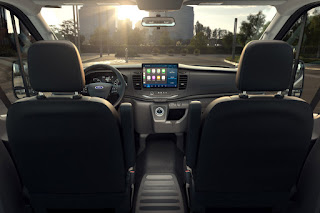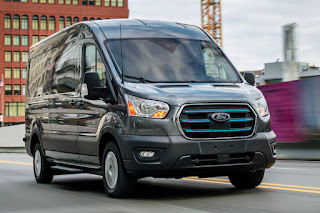Ford unveils the pure-electric E-Transit
Electric delivery vehicles are destined to become much more common, thanks mainly to an increasing number of low emissions zones and the possibility of combustion-engine bans in some city centres. Ford’s response is the E-Transit, which will be offered in panel van, double-cab-in-van and chassis cab guises across Europe.
The E-Transit features a single electric motor that sends 265 bhp (198 kW / 269 PS) plus 430 Nm (317 lb-ft) of torque to the rear axle.
However, for many prospective customers, range is likely to be just as important as output. They shouldn’t be too concerned, because a large 67 kWh battery pack is fitted beneath the floor. The result is an estimated WLTP Combined driving range of 217 miles (350 kilometres).
If energy levels are running low, then topping up from 15 to 80 percent capacity takes about half an hour via a 115 kW DC facility. Alternatively, the on-board 11.3 kW AC charger is able to fully replenish a flat battery in just over eight hours.
The E-Transit has the same cargo volume as a regular diesel-powered rear-wheel drive Transit. Anticipated maximum payload is 1,616 kg (3,562 lb) for the panel van, while the equivalent figure for the chassis cab version is 1,967 kg (4,336 lb).
Ford is going to manufacture the E-Transit in both Turkey and the United States. Fleet trials with European operators are scheduled to take place next year, ahead of full market launches in spring 2022.
Related posts:
Ford has introduced a five-tonne Transit
Pure-electric Citroën e-Jumper van unveiled
2021 Fiat E-Ducato sales begin in the UK
The E-Transit features a single electric motor that sends 265 bhp (198 kW / 269 PS) plus 430 Nm (317 lb-ft) of torque to the rear axle.
However, for many prospective customers, range is likely to be just as important as output. They shouldn’t be too concerned, because a large 67 kWh battery pack is fitted beneath the floor. The result is an estimated WLTP Combined driving range of 217 miles (350 kilometres).
If energy levels are running low, then topping up from 15 to 80 percent capacity takes about half an hour via a 115 kW DC facility. Alternatively, the on-board 11.3 kW AC charger is able to fully replenish a flat battery in just over eight hours.
The E-Transit has the same cargo volume as a regular diesel-powered rear-wheel drive Transit. Anticipated maximum payload is 1,616 kg (3,562 lb) for the panel van, while the equivalent figure for the chassis cab version is 1,967 kg (4,336 lb).
Ford is going to manufacture the E-Transit in both Turkey and the United States. Fleet trials with European operators are scheduled to take place next year, ahead of full market launches in spring 2022.
Related posts:
Ford has introduced a five-tonne Transit
Pure-electric Citroën e-Jumper van unveiled
2021 Fiat E-Ducato sales begin in the UK





%2BDashboard.jpg)

+Front+Side.jpg)

+Front+Side.jpg)

Comments
Post a Comment